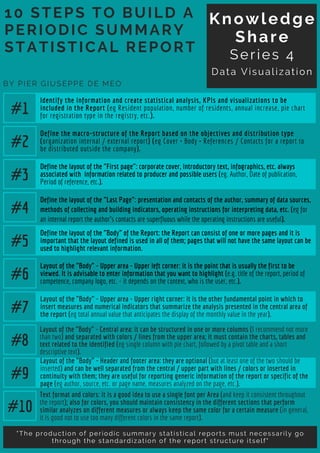
10 Steps to build a periodic summary statistical report
- 1. 10 STEPS TO BUILD A PERIODIC SUMMARY STATISTICAL REPORT BY PIER GIUSEPPE DE MEO #1 Identify the information and create statistical analysis, KPIs and visualizations to be included in the Report (eg Resident population, number of residents, annual increase, pie chart for registration type in the registry, etc.). Knowledge Share Series 4 Data Visualization "The production of periodic summary statistical reports must necessarily go through the standardization of the report structure itself" #2 Define the macro-structure of the Report based on the objectives and distribution type (organization internal / external report) (eg Cover + Body + References / Contacts for a report to be distributed outside the company). #3 Define the layout of the "First page": corporate cover, introductory text, infographics, etc. always associated with information related to producer and possible users (eg. Author, Date of publication, Period of reference, etc.). #4 Define the layout of the "Last Page": presentation and contacts of the author, summary of data sources, methods of collecting and building indicators, operating instructions for interpreting data, etc. (eg for an internal report the author's contacts are superfluous while the operating instructions are useful). #5 Define the layout of the "Body" of the Report: the Report can consist of one or more pages and it is important that the layout defined is used in all of them; pages that will not have the same layout can be used to highlight relevant information. #6 Layout of the "Body" - Upper area - Upper left corner: it is the point that is usually the first to be viewed. It is advisable to enter information that you want to highlight (e.g. title of the report, period of competence, company logo, etc. - it depends on the context, who is the user, etc.). #7 Layout of the "Body" - Upper area - Upper right corner: it is the other fundamental point in which to insert measures and numerical indicators that summarize the analysis presented in the central area of the report (eg total annual value that anticipates the display of the monthly value in the year). #9 Layout of the "Body" - Header and footer area: they are optional (but at least one of the two should be inserted) and can be well separated from the central / upper part with lines / colors or inserted in continuity with them; they are useful for reporting generic information of the report or specific of the page (eg author, source, etc. or page name, measures analyzed on the page, etc.). #10 Text format and colors: it is a good idea to use a single font per Area (and keep it consistent throughout the report); also for colors, you should maintain consistency in the different sections that perform similar analyzes on different measures or always keep the same color for a certain measure (in general, it is good not to use too many different colors in the same report). #8 Layout of the "Body" - Central area: it can be structured in one or more columns (I recommend not more than two) and separated with colors / lines from the upper area; it must contain the charts, tables and text related to the identified (eg single column with pie chart, followed by a pivot table and a short descriptive text).
